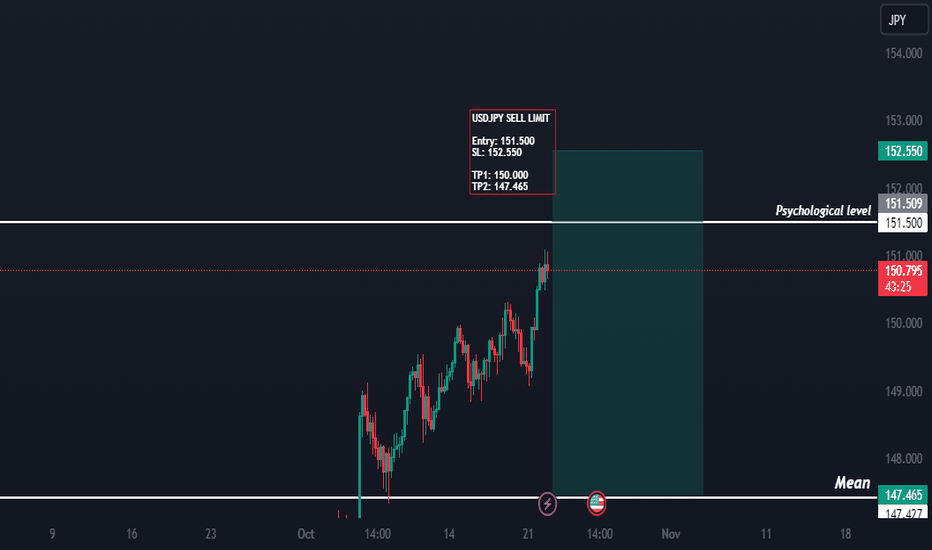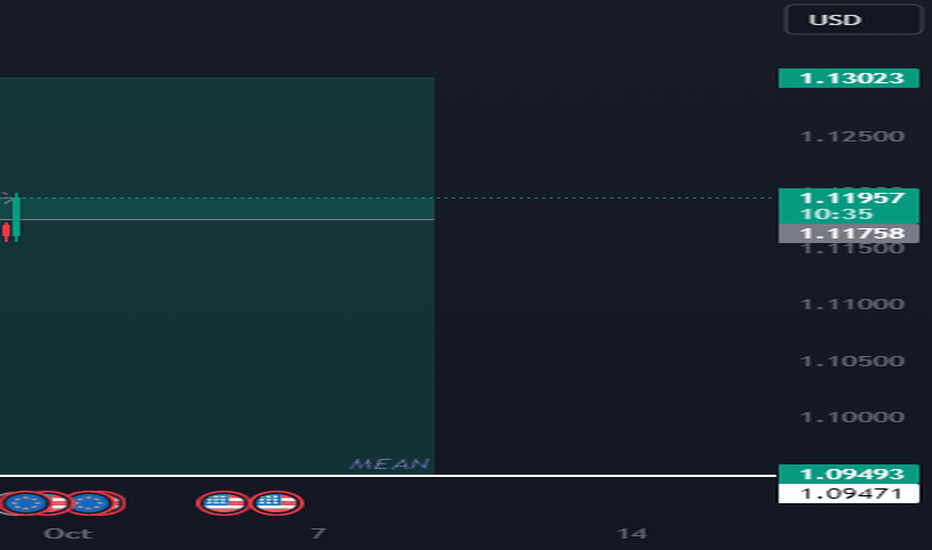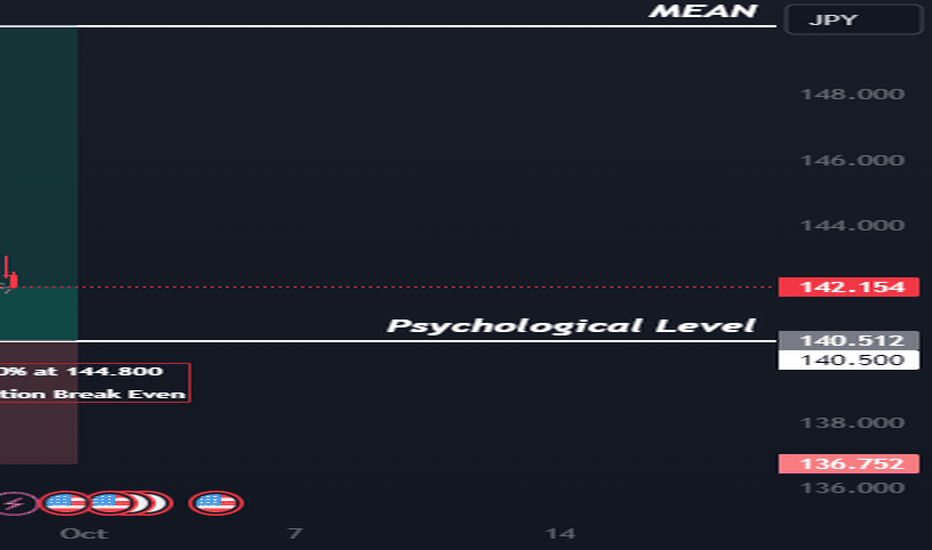USDJPY Daily Analysis: A Slight Bearish Bias Expected!!Introduction
Today’s analysis of the USDJPY pair suggests a potential for slight bearish movement. Key fundamental factors, including recent US and Japanese economic data and central bank positions, seem to favor a downside bias. Let’s examine these drivers in detail to provide a comprehensive view for traders and investors monitoring the USDJPY.
1. Federal Reserve’s Dovish Tone
The US Federal Reserve’s latest communication indicates a cautious approach, with market participants widely expecting the Fed to maintain its current interest rate. This dovish tone, coupled with moderating US economic data, could weaken the US Dollar. If the Fed holds rates or hints at potential rate cuts in 2024, this could weigh on the USD, providing room for JPY strength against the Dollar. Consequently, the market’s perception of a less aggressive Fed policy may contribute to the USDJPY pair’s bearish bias today.
2. Bank of Japan’s Evolving Stance
The Bank of Japan (BoJ) has recently shown signs of potentially moving away from its ultra-loose policy stance. Governor Kazuo Ueda’s comments have signaled a potential shift in monetary policy, raising speculation around adjustments in yield control measures. Any further tightening of Japanese yields or gradual normalization signals may strengthen the JPY as Japanese bond yields rise, attracting capital inflows. This shift, however gradual, could support a stronger JPY, thereby pressuring USDJPY downward.
3. Japanese Economic Resilience
Japan’s economy has recently demonstrated steady resilience, with improved inflation data aligning closer to the BoJ’s targets. Stronger-than-expected inflation readings and positive manufacturing activity lend support to the JPY. The BoJ’s confidence in these indicators may reinforce market sentiment that Japan is on a steady path to growth. Consequently, with USD expected to remain relatively soft, this positions the JPY more favorably in the USDJPY pair, reinforcing today’s bearish outlook.
4. Risk Sentiment and Safe-Haven Flows
In today’s mixed risk sentiment environment, safe-haven assets like the JPY often become more attractive. Investors may favor the JPY in times of global economic uncertainty or as geopolitical events unfold. As the US Dollar is pressured by softer economic indicators, the JPY’s safe-haven appeal may drive demand, contributing to USDJPY’s bearish tendency today.
Conclusion
In conclusion, the USDJPY pair shows potential for a slight bearish bias today due to the Fed’s cautious stance, the BoJ’s gradual policy evolution, resilient Japanese economic data, and safe-haven flows favoring the JPY. Traders may find it beneficial to watch these fundamental factors closely, as they provide critical insights into USDJPY’s likely direction.
Keywords:
#USDJPYanalysis,
#USDollar,
#JapaneseYen,
#USDJPYbearishbias,
#ForextradingNovember12024,
#FederalReservepolicy,
#Bankof Japanstance,
#JPYstrength,
#Safehavencurrency,
#Forextechnicalanalysis,
#Japaneseinflationdata,
#Forextradinginsights.
Federalreservepolicy
USDJPY Slightly Bearish Bias on October 22, 2024 !!USDJPY Slightly Bearish Bias on October 22, 2024: Key Drivers and Analysis
As of October 22, 2024, the USDJPY currency pair is exhibiting a slightly bearish bias based on the latest market conditions and fundamental factors. In this article, we’ll break down the key drivers that could contribute to this potential weakness in the US Dollar (USD) against the Japanese Yen (JPY) and provide insights for traders looking to capitalize on these movements.
1. Dovish Federal Reserve Outlook Weakens USD
The US Dollar has been losing momentum in recent sessions due to a shift in market sentiment around the future path of the Federal Reserve's monetary policy. Recent economic data out of the US, including softer-than-expected retail sales and a slowdown in the housing market, have led traders to anticipate a more dovish approach from the Fed.
Despite persistent inflationary pressures, the Federal Reserve has signaled that it may pause rate hikes, which is reducing demand for the USD. This pause in tightening is making the USDJPY pair more vulnerable to downside risks, especially as traders shift to safer assets like the JPY in the face of rising uncertainty in global markets.
2. Bank of Japan's Potential Policy Shift
The Bank of Japan (BoJ) has remained committed to its ultra-loose monetary policy for years, but there are signs that it may be reconsidering its stance. Speculation has grown that the BoJ might tweak its yield curve control (YCC) program or adjust its negative interest rates policy in the near future. Even though no official changes have been announced, the potential for a more hawkish policy shift is providing underlying support to the JPY.
Investors are also pricing in the possibility that inflationary pressures in Japan could push the BoJ toward policy normalization, which would make the JPY more attractive relative to the USD.
3. Safe-Haven Demand for JPY Amid Global Uncertainty
The Japanese Yen is traditionally viewed as a safe-haven currency, meaning that it tends to gain strength during periods of global uncertainty. Current geopolitical tensions, particularly in the Middle East, and concerns over global economic slowdown are driving risk aversion in the markets. This sentiment is boosting demand for safe-haven assets, including the JPY, while pressuring the USDJPY pair lower.
Furthermore, ongoing concerns about China's economic recovery and lingering trade tensions between the US and other major economies are also contributing to increased risk-off sentiment, which favors the Yen over the Dollar.
4. Diverging Economic Data Between the US and Japan
While the US economy has been showing signs of weakness, with disappointing retail sales and housing market reports, Japan’s latest GDP data surprised to the upside. The Japanese economy grew faster than expected in the last quarter, reinforcing the view that the country is starting to recover from its prolonged period of stagnation. This stronger economic outlook for Japan is providing additional tailwinds for the Yen.
In contrast, US data continues to reflect a potential slowdown, leading traders to rethink their bullish stance on the USD. The combination of weaker economic performance in the US and stronger-than-expected growth in Japan is tilting the balance toward a bearish USDJPY outlook.
5. Technical Analysis and Market Sentiment
From a technical perspective, the USDJPY pair has recently tested key resistance levels around 150.00 but failed to break higher, suggesting that a reversal may be underway. The pair is now trading closer to 148.50, with the potential to move lower if further downside pressure builds. Traders are watching for a break below the 148.00 support level, which could signal additional bearish momentum.
Market sentiment, as indicated by the Commitment of Traders (COT) report, shows a slight increase in speculative short positions on the USDJPY pair, reflecting the broader expectation of near-term weakness in the USD.
6. Yen Intervention Concerns
Another factor adding to the bearish bias for USDJPY is the potential for Japanese government intervention. In the past, Japan’s Ministry of Finance has intervened in the currency markets to support the Yen when it experiences excessive weakness. With USDJPY approaching levels that could trigger intervention, traders are cautious about pushing the pair higher, which is contributing to the pair’s bearish momentum.
The Japanese authorities have issued warnings in recent weeks about excessive volatility in the Yen, and this potential intervention risk is helping to keep USDJPY in check.
Conclusion: USDJPY Outlook for October 22, 2024
In conclusion, the USDJPY pair is expected to maintain a slightly bearish bias today due to several key factors, including the dovish Federal Reserve outlook, potential Bank of Japan policy shifts, and rising safe-haven demand for the Yen. The divergence in economic data between the US and Japan, coupled with technical indicators signaling downside potential, further strengthens the case for a weaker USDJPY pair in today’s trading session.
Traders should keep a close eye on upcoming economic reports from both the US and Japan, as well as any potential intervention from Japanese authorities, which could impact the pair’s trajectory. For those trading forex, today’s market environment may present opportunities to capitalize on short positions in USDJPY.
Keywords for SEO Ranking:
- USDJPY analysis,
- Bearish bias,
- US Dollar,
- Japanese Yen,
- USDJPY forecast,
- Forex trading,
- Currency markets,
- Federal Reserve policy,
- Bank of Japan,
- Yield curve control,
- Safe-haven currency,
- Technical analysis,
- Forex trends,
- Forex market update,
- Currency pair analysis,
- USDJPY today,
- Forex news,
- Forex signals.
EURUSD Daily Outlook: Slight Bearish Bias Expected on 30/09/2024EURUSD Daily Outlook: Slight Bearish Bias Expected on 30/09/2024
As of today, 30/09/2024, the EURUSD pair appears to be trending towards a slightly bearish bias, driven by a mix of fundamental and technical factors. Traders should be aware of the potential downside risks, particularly given the current market environment. Let’s dive into the key drivers behind this forecast.
1. Eurozone Economic Weakness
One of the primary reasons for the expected bearish bias on EURUSD is the ongoing economic challenges within the Eurozone. Recent economic data, including declining manufacturing output and weaker-than-expected consumer confidence figures, has contributed to a gloomy outlook for the Euro. The European Central Bank (ECB) has remained cautious, avoiding any strong hawkish stance, which continues to weigh on the Euro's performance. The lack of aggressive monetary tightening by the ECB, compared to the Federal Reserve, places further pressure on the currency.
2. Federal Reserve Hawkish Stance
On the other side of the equation, the US Dollar (USD) remains supported by the Federal Reserve's hawkish monetary policy. Jerome Powell’s recent statements highlight the possibility of further interest rate hikes in the near term to combat inflation. This is a strong bullish factor for the USD, making the EURUSD pair more vulnerable to downward pressure. The market anticipates that the Fed will continue to outpace the ECB in terms of tightening monetary conditions, widening the interest rate differential.
3. US Economic Strength
Recent US economic data has reinforced the Dollar’s strength. Strong retail sales, robust employment figures, and better-than-expected GDP growth have all contributed to a more resilient USD. In contrast, the Eurozone struggles with stagnation, providing further evidence that the EURUSD pair is likely to face headwinds today. The divergent economic outlooks between the US and the Eurozone will likely push EURUSD lower.
4. Technicals Support Bearish Sentiment
From a technical perspective, EURUSD is currently testing support levels around 1.0850. A break below this could signal further downside movement. The 50-day moving average has also started to slope downward, reinforcing the short-term bearish outlook. Momentum indicators such as the RSI (Relative Strength Index) are approaching oversold levels, but there’s still room for further declines before a potential rebound.
5. Geopolitical Uncertainty
Geopolitical uncertainty in Europe, particularly around energy security and trade tensions, adds to the Euro’s vulnerability. Investors are seeking safe-haven assets, including the USD, amid these risks, which is another reason for the slight bearish bias on EURUSD today.
Conclusion
Based on the latest fundamental factors and current market conditions, EURUSD is expected to experience a slight bearish bias on 30/09/2024. The combination of Eurozone economic weakness, the Fed's hawkish stance, strong US economic data, technical indicators, and geopolitical risks all contribute to this outlook. Traders should watch key support levels and any developments in economic data to confirm or adjust their positions.
Keywords for SEO Optimization:
EURUSD analysis, EURUSD forecast, EURUSD bearish bias, Euro to USD forecast, Forex analysis, EURUSD technical analysis, 30/09/2024 EURUSD, Eurozone economy, Federal Reserve policy, USD strength, Forex trading, EURUSD support levels, Forex technical indicators, Euro dollar analysis September 2024, Forex trading signals, EURUSD market outlook.
USDJPY Analysis: Anticipating a Slight Bearish Bias for Next WeeUSDJPY Analysis: Anticipating a Slight Bearish Bias for Next Week
Date: 28/09/2024
As we look ahead to the coming week for the USDJPY currency pair, a slight bearish bias seems likely based on the latest fundamental factors and market conditions. Several key drivers contribute to this outlook, and in this article, we'll explore the factors that may weigh on the USDJPY pair, creating potential opportunities for traders.
1. Dovish Signals from the Federal Reserve
One of the primary drivers for USDJPY's potential bearish bias next week is the recent dovish shift in the Federal Reserve's tone. While the Fed has maintained a firm stance on keeping interest rates elevated to curb inflation, recent economic data in the U.S. suggest that inflationary pressures may be easing. If the Fed signals a slower pace of tightening or hints at rate cuts in the future, this could weaken the U.S. dollar, pushing the USDJPY lower.
The key phrase here is "inflation slowdown," as this could be the primary focus in upcoming economic releases. Traders should keep a close eye on any updates from Federal Reserve Chair Jerome Powell and other policymakers, as dovish commentary could lead to further USD weakness.
2. Japan's Central Bank Policy
On the other side of the coin, the Bank of Japan (BoJ) continues its ultra-loose monetary policy. While the BoJ has resisted raising interest rates, there have been increasing discussions around tweaking its yield curve control (YCC) program. If the BoJ surprises markets by adjusting its policy, this could provide a boost to the Japanese yen, exerting downward pressure on USDJPY.
The BoJ's governor, Kazuo Ueda, has emphasized that they will remain accommodative, but with inflation in Japan beginning to rise, markets may start to price in a more hawkish BoJ in the near future.
3. U.S. Economic Data and Dollar Sentiment
U.S. data releases, including the upcoming non-farm payrolls (NFP) report and the core PCE (Personal Consumption Expenditures) index, will be crucial in shaping the USDJPY trend next week. A weak NFP or lower-than-expected PCE inflation figures could weigh on the U.S. dollar, contributing to a bearish outlook for USDJPY.
Additionally, geopolitical tensions or unexpected developments in global markets could drive safe-haven demand for the yen, pushing USDJPY lower. With risk-off sentiment growing due to uncertainties in global markets, the yen may see inflows as investors seek safety.
4. Technical Analysis
From a technical perspective, USDJPY has been hovering near key resistance levels, and the pair’s inability to break higher could signal a pullback. If USDJPY fails to hold above the 149.00 level, it could retrace toward the 147.50 and 146.00 support areas. Short-term momentum indicators, such as the RSI (Relative Strength Index), are showing signs of overbought conditions, further supporting the potential for a corrective move lower.
Conclusion
In summary, the USDJPY currency pair could experience a slightly bearish bias next week, driven by dovish signals from the Federal Reserve, potential shifts in Japan’s monetary policy, and weaker U.S. economic data. Traders should remain vigilant about key data releases, Fed speeches, and any surprises from the Bank of Japan. As always, proper risk management is crucial when navigating currency markets.
Stay tuned for more updates on USDJPY and other forex pairs. As we enter a potentially volatile week, it's essential to monitor these key drivers and make informed trading decisions.
Keywords: USDJPY analysis, Federal Reserve policy, Bank of Japan, USDJPY bearish bias, forex trading, USDJPY technical analysis, USDJPY forecast, U.S. economic data, dovish Fed signals, forex trading signals, tradingview analysis



